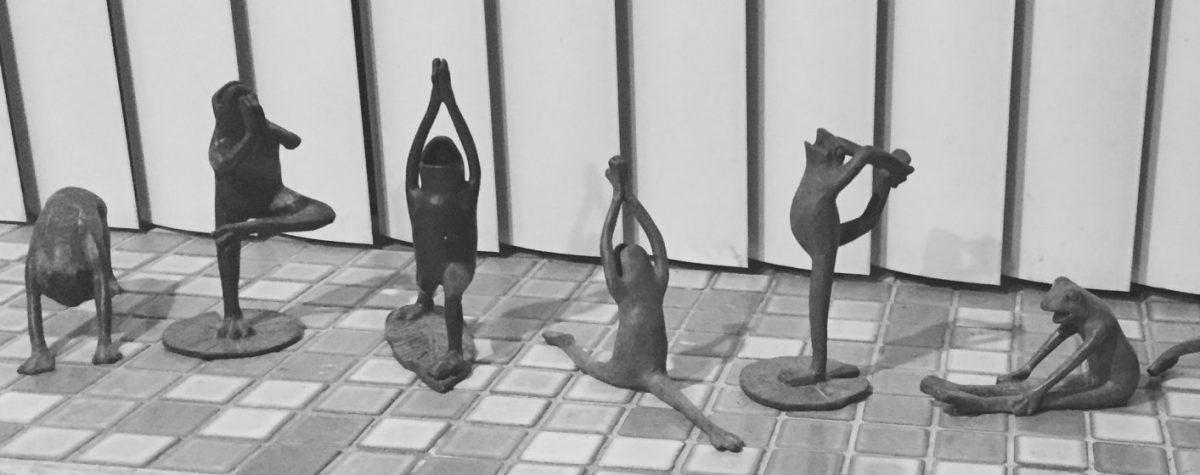“In Iyengar’s first classes in London in 1966, there were no mats,” recalls Angela Farmer, who remained his student for ten years, when in London and at his yoga institute in Pune, India; eventually becoming a Certified Iyengar Yoga Teacher.
Angela grew up near London. “In my early teens I had double surgery, first to sever and remove five ganglions of nerves on both sides of my [cervical spine] and the following year the same from my lumbar spine.” “Doctors said it would cure a circulatory condition caused most likely from the three and a half hours I spent each day in a train going to and from school in London, surrounded by businessmen, all chainsmokers.” “Since then I have lived with major loss of feeling in my hands and feet, inability to sweat, sterility…, no possibility of ever conceiving…, and inability to adapt to changes of temperature amongst other side-effects. The psychological damage was huge, but in those days no attention was paid to any of this.”
“My feet would slide apart and I had to tense my legs to keep from falling,” Angela calls to mind. “I was desperate to find something that would give me traction.”
Farmer tried using blankets, a bulky foam mattress, even water and spit, but Iyengar forbid it. “I was too much afraid, and in awe of him, to even think of mentioning the surgeries.”
One day while on a teaching assignment in Germany, Farmer spotted a roll of matting at a local market. It turned out to be carpet padding. She bought a length of it and took it to class. “It was heaven”, Farmer thinks back to being able to grip the floor without straining. Meanwhile, “in London my students all wanted a similar mat, so the next trip to Munich I returned with an armful.”
“My father decided to do some research and discovered the manufacturers in a small village in Bavaria.” Thus becoming the first retailer of the ‘Molivos Mat’, having named it in honor of his daughter’s workshops in Molivos, Lesvos, Greece.
“Iyengar was against using mats in the early years, but later he had heavy black mats brought from Holland and then still later, I was told, his studio was supplied with ‘Molivos mats’.” Angela reminisces, “I had to smile at this circle of events.”
In 1986, Sarah Chambers founded Hugger Mugger Yoga Products in Salt Lake City, Utah. Chambers was a custom furniture builder and a student of the Iyengar Yoga teachers Cita Mason and David Riley, who were a physical therapist and medical doctor in their non-teaching lives. During a workshop Chambers attended, Mary Dunn used a belt to demonstrate modifications. This led Sarah to create a 1 and 1/2 inch-wide cotton double D-ring strap, yoga shorts, and later manufacture more Iyengar-inspired yoga props in her basement.
Sarah also began importing and selling the makeshift yoga mats, cut from the same German carpet underlay. However, export duties and international shipping costs made these European mats expensive in North America. In addition, when learning that this material crumbled after a few months, Chambers sought a chemist’s help. In 1990, working with a U.S.-based company, the ‘Tapas Mat’ was developed, becoming the first-ever nonskid mat designed specifically for yoga. The same U.S. company still makes these yoga mats. Most other mats on the market are based on Sarah’s original design.
German manufacturers didn’t give up, though. They developed a new line of high-quality mats in three different colors and varied levels of thickness. Today, there are many, many types and brands of “sticky” yoga mats.
How to choose? Thick? Thin? Synthetic or natural? PVC based, or an eco friendly version? Consumer’s Advocate did an extensive analysis of several yoga mats and has published their results. You’ll be glad, as I, to see that this site informs readers of their policy at the top of their page.
We use both the German, and Tapas mats at our Studio. However if we ever replace them, we’ll choose an eco-friendly, sustainable version. Peace
